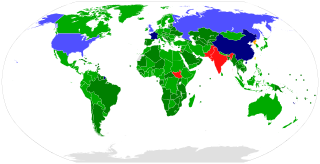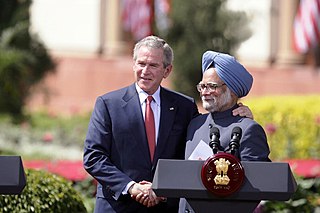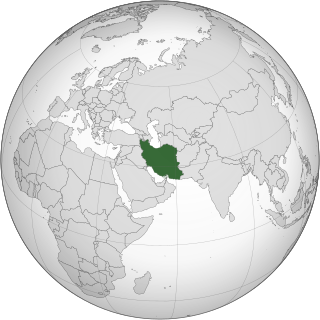
The International Atomic Energy Agency (IAEA) is an intergovernmental organization that seeks to promote the peaceful use of nuclear energy and to inhibit its use for any military purpose, including nuclear weapons. It was established in 1957 as an autonomous organization within the United Nations system; though governed by its own founding treaty, the organization reports to both the General Assembly and the Security Council of the United Nations, and is headquartered at the UN Office at Vienna, Austria.

The Treaty on the Non-Proliferation of Nuclear Weapons, commonly known as the Non-Proliferation Treaty or NPT, is an international treaty whose objective is to prevent the spread of nuclear weapons and weapons technology, to promote cooperation in the peaceful uses of nuclear energy, and to further the goal of achieving nuclear disarmament and general and complete disarmament. Between 1965 and 1968, the treaty was negotiated by the Eighteen Nation Committee on Disarmament, a United Nations-sponsored organization based in Geneva, Switzerland.

Nuclear proliferation is the spread of nuclear weapons, fissionable material, and weapons-applicable nuclear technology and information to nations not recognized as "Nuclear Weapon States" by the Treaty on the Non-Proliferation of Nuclear Weapons, commonly known as the Non-Proliferation Treaty or NPT. Proliferation has been opposed by many nations with and without nuclear weapons, as governments fear that more countries with nuclear weapons will increase the possibility of nuclear warfare, de-stabilize international or regional relations, or infringe upon the national sovereignty of nation states.

The Nuclear Suppliers Group (NSG) is a multilateral export control regime and a group of nuclear supplier countries that seek to prevent nuclear proliferation by controlling the export of materials, equipment and technology that can be used to manufacture nuclear weapons.
Iran has several research sites, two uranium mines, a research reactor, and uranium processing facilities that include three known uranium enrichment plants.
William C. Potter is Sam Nunn and Richard Lugar Professor of Nonproliferation Studies and Founding Director of the James Martin Center for Nonproliferation Studies at the Middlebury Institute of International Studies at Monterey (MIIS). He also directs the MIIS Center for Russian and Eurasian Studies.

Iran is not known to currently possess weapons of mass destruction (WMD) and has signed treaties repudiating the possession of WMDs including the Biological Weapons Convention, the Chemical Weapons Convention, and the Non-Proliferation Treaty (NPT). Iran has first-hand knowledge of WMD effects—over 100,000 Iranian troops and civilians were victims of chemical weapons during the 1980s Iran–Iraq War.
A nuclear fuel bank is reserve of low enriched uranium (LEU) for countries that need a backup source of LEU to fuel their nuclear reactors. Countries that do have enrichment technology would donate enriched fuel to a "bank", from which countries not possessing enrichment technology would obtain fuel for their power reactors.

The 123 Agreement signed between the United States of America and the Republic of India is known as the U.S.–India Civil Nuclear Agreement or Indo-US nuclear deal. The framework for this agreement was a July 18, 2005, joint statement by then Indian Prime Minister Manmohan Singh and then U.S. President George W. Bush, under which India agreed to separate its civil and military nuclear facilities and to place all its civil nuclear facilities under International Atomic Energy Agency (IAEA) safeguards and, in exchange, the United States agreed to work toward full civil nuclear cooperation with India. This U.S.-India deal took more than three years to come to fruition as it had to go through several complex stages, including amendment of U.S. domestic law, especially the Atomic Energy Act of 1954, a civil-military nuclear Separation Plan in India, an India-IAEA safeguards (inspections) agreement and the grant of an exemption for India by the Nuclear Suppliers Group, an export-control cartel that had been formed mainly in response to India's first nuclear test in 1974. In its final shape, the deal places under permanent safeguards those nuclear facilities that India has identified as "civil" and permits broad civil nuclear cooperation, while excluding the transfer of "sensitive" equipment and technologies, including civil enrichment and reprocessing items even under IAEA safeguards. On August 18, 2008, the IAEA Board of Governors approved, and on February 2, 2009, India signed an India-specific safeguards agreement with the IAEA. After India brought this agreement into force, inspections began in a phased manner on the 35 civilian nuclear installations India has identified in its Separation Plan. The deal is seen as a watershed in U.S.-India relations and introduces a new aspect to international nonproliferation efforts. On August 1, 2008, the IAEA approved the safeguards agreement with India, after which the United States approached the Nuclear Suppliers Group (NSG) to grant a waiver to India to commence civilian nuclear trade. The 48-nation NSG granted the waiver to India on September 6, 2008, allowing it to access civilian nuclear technology and fuel from other countries. The implementation of this waiver made India the only known country with nuclear weapons which is not a party to the Non-Proliferation Treaty (NPT) but is still allowed to carry out nuclear commerce with the rest of the world.

United Nations Security Council Resolution 1696, adopted on July 31, 2006, after expressing concern at the intentions of the nuclear programme of Iran, the Council demanded that Iran halt its uranium enrichment programme.

Libya pursued programs to develop or acquire weapons of mass destruction from when Muammar Gaddafi seized control of Libya in 1969 until he announced on 19 December 2003 that Libya would voluntarily eliminate all materials, equipment and programs that could lead to internationally proscribed weapons. This included weapons of mass destruction and long-range ballistic missiles.

A multilateral export control regime is an informal group of like-minded supplier countries that seek to contribute to the non-proliferation of weapons of mass destruction, delivery systems, and advanced conventional weapons through national implementation of guidelines and control lists for exports. For a chart of national membership in different regimes, see the SIPRI Yearbook chapter on "Transfer controls".
President Adly Mansour announced on 7 November 2013 that Egypt was restarting its nuclear power program in El Dabaa; a deal was reached with the residents in which it was agreed that a residential area will also be built. The Egyptian minister of electricity, Ahmed Emam, has called the project "necessary" because of a small amount of renewable energy sources and not enough fuel.

International Atomic Energy Agency (IAEA) Safeguards are a system of inspection and verification of the peaceful uses of nuclear materials as part of the Nuclear Non-Proliferation Treaty (NPT), supervised by the International Atomic Energy Agency.
The 2010 Review Conference for the Treaty on the Non-Proliferation of Nuclear Weapons (NPT) was held at United Nations Headquarters in New York City from 3 to 28 May 2010. The President of the Review Conference is Ambassador Libran N. Cabactulan of the Philippines. UN Secretary-General Ban Ki-moon used the opening of the conference to note that "sixty five years later, the world still lives under the nuclear shadow".

Nuclear Non-Proliferation Act of 1978, 22 U.S.C. § 3201, is a United States federal law declaring that nuclear explosive devices pose a perilous threat to the security interests of the United States. The law restricts U.S. export of civil nuclear programs to other states.

After World War II, Sweden considered building nuclear weapons to defend themselves against an offensive assault from the Soviet Union. From 1945 to 1972 the government ran a clandestine nuclear weapons program under the guise of civilian defense research at the Swedish National Defence Research Institute (FOA).
The Hydrometallurgy Pilot Plant (HPP) is a hot cell laboratory complex, dedicated to perform bench-scale radiochemistry experiments including the separation of plutonium and uranium from the spent fuel rods of the ETRR-1 research reactor and was established in 1982. The HPP is owned and operated by the Egyptian Atomic Energy Authority (AEA) at the Nuclear Research Center in Inshas, northeast of Cairo.
Material unaccounted for (MUF), in the context of nuclear material, refers to any discrepancy between a nuclear-weapons state's physical inventory of nuclear material, and the book inventory. The difference can be either a positive discrepancy or a negative discrepancy. Nuclear accounting discrepancies are commonplace and inevitable due to the problem of accurately measuring nuclear materials. This problem of inaccurate measurement provides a potential loophole for diversion of nuclear materials for weapons production. In a large plant, even a tiny percentage of the annual through-put of nuclear material will suffice to build one or more nuclear weapons.

 Argentina
Argentina  Australia
Australia  Austria
Austria  Belarus
Belarus  Belgium
Belgium  Bulgaria
Bulgaria  Canada
Canada  China
China  Croatia
Croatia  Czech Republic
Czech Republic  Denmark
Denmark  Finland
Finland  France
France  Germany
Germany  Greece
Greece  Hungary
Hungary  Ireland
Ireland  Italy
Italy  Japan
Japan  Kazakhstan
Kazakhstan  South Korea
South Korea  Luxembourg
Luxembourg  Netherlands
Netherlands  New Zealand
New Zealand  Norway
Norway  Poland
Poland  Portugal
Portugal  Romania
Romania  Russia
Russia  Slovakia
Slovakia  Slovenia
Slovenia  South Africa
South Africa  Spain
Spain  Sweden
Sweden  Switzerland
Switzerland  Turkey
Turkey  Ukraine
Ukraine  United Kingdom
United Kingdom  United States
United States ![]() European Commission is a permanent observer.
European Commission is a permanent observer.










